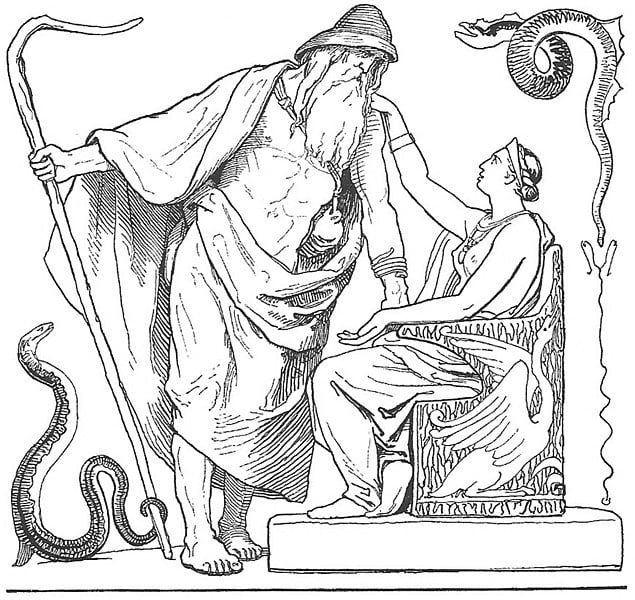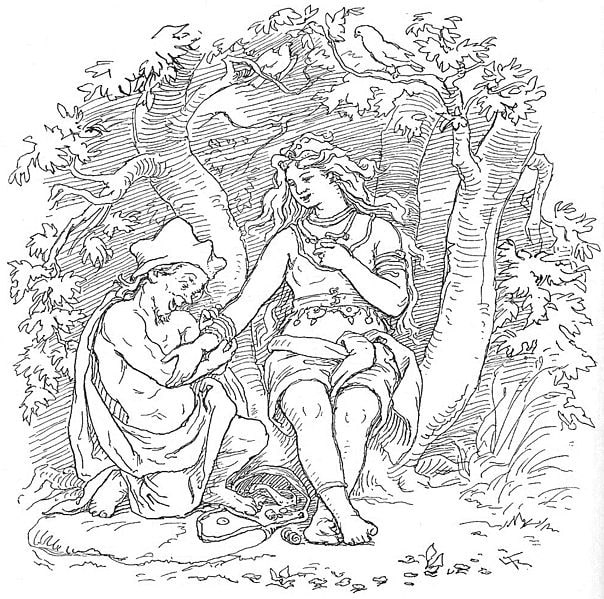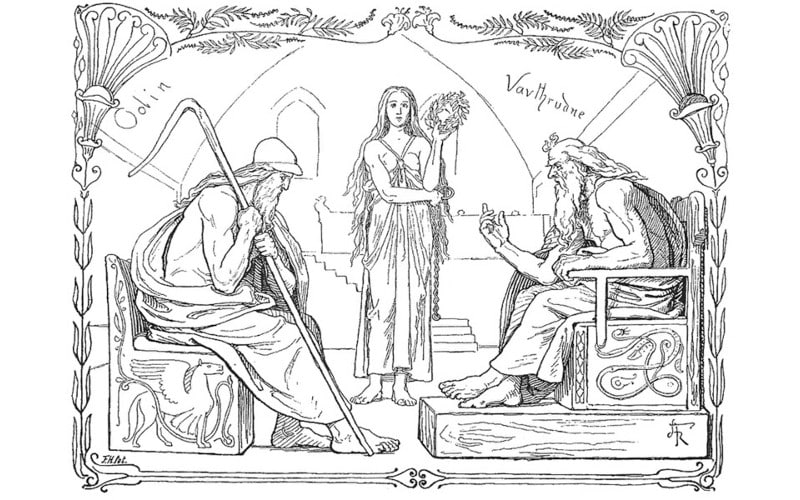In Norse mythology, the jötnar, or giants, hold a place of intrigue and wisdom, often cast as antagonists in stories. Among them, Vafthruthnir stands out as the most knowledgeable, at least if we are to believe Odin’s wife Frigg.
This ancient poem is an important part of the preserved works as it lists many mythological facts from Norse mythology.
From the Poetic Edda poem Vafthrudnismál, stanza two, we can read Frigg’s advice to Odin when he tells her he wants to meet Vafthrudnir. In the below translation, “might” refers to his intellect, wisdom and deep knowledge of ancient lore, not physical power.
Frigg spoke:
- “All-father here at home would I keep,
Where the gods dwell together;
Among all the giants I know no equal
To Vafthruthnirs’ might.”

Unlike his kin, who are often portrayed in tales of strength and conflict with the gods, Vafthruthnir’s might lies in his vast understanding of the cosmos and the secrets it holds. His encounters with the gods, particularly Odin, highlight a different aspect of the jötnar, showcasing their depth beyond mere brute force.
It is Odin’s eternal quest for wisdom, in his pursuit to avoid the inevitable doom of the gods, that is the foundation for the Vafthrudnismál. In the poem, we get to know the wise old jötun. It also gives a glimpse into the complex relationship between the gods and the jotnar.
Name and Etymology
The wise old jötun’s name in Old Norse was Vafþrúðnir, anglicized as Vafthrudnir. The meaning of it is likely something along the lines of “The Mightiest Riddler”. From Old Norse, ‘Vaf’ in this instance means to weave, and -thrudnir means strong or mighty. Like is so often the case with Old Norse names, Vaf isn’t meant literally. He is a weaver of words, as in a master at crafting riddles.
The -thrudnir part is also the source for the name of Thor’s daughter Thrud. What better name for a warrior goddess than Mighty.
While there are some small variations you could argue in how to understand the name, it is fairly straightforward. Nonetheless I have seen some variants that just don’t add up. One that comes to mind is ‘Riddle Weaver’ which is used in a popular version of the Poetic Edda. This just doesn’t make sense though as both riddle, and weaver are derived from the ‘Vaf’ part of the name. What about the ‘-thrudnir’ ending then?
Vafthruthnir’s Origins and Background
I have always found Vafthruthnir’s origins interesting when considering them in a broader perspective. First off, he is apparently the wisest of the jotnar, yet his name doesn’t really reflect this. In another poem from the Poetic Edda, the Álvismál, there is a dwarf named Alviss, meaning All-wise. In that poem Thor and the dwarf also contend in a battle of wits of sorts. The dwarf’s name is directly associated with him being the wisest of the dwarves, or svartálfar.

Vafthrudnir’s name however, reflects his unparalleled talent in weaving riddles, which doesn’t necessarily require him being wise. Instead he could have been a master poet, or indeed good with riddles, going by his name alone.
You can often find parallels with ancient Greek mythology when analyzing Norse myths. In this case, it is tempting to look at the tale of the Sphinx. It was guarding the entry, or merely terrorizing, travelers on the road to the city of Thebes.
It would pose a riddle, and until the hero Oedipus managed to answer it, the unlucky ones before him had been killed by the Sphinx. When Oedipus eventually managed to provide the answer, the Sphinx killed herself.
It is never explicitly said in the Vafthrudnismál, or any other source, but I do believe that Vaftrudnir lost his head in the end.
Riddles in Heidreks saga
There is another Old Norse saga in which Odin is also involved in a series of riddles associated with ancient lore. It is found in the Hervarar saga ok Heiðreks which is sort of cobbled together in three different parts. One part is called Gátur Gestumblinda, (Riddles of Gestumblindi) and there Odin, in the guise of a man called Gestumblindi, exchanges a series of riddles with a prince named Heithrek. Maybe the most classic of these riddles is the ‘Horse and rider’ riddle.
Who are those two
that run on ten feet,
have three eyes
but only one tail?
Ponder this riddle
O prince Heidrek!
The answer of course is Odin when he rides on Sleipnir, and this is a good example of how the riddles aren’t all that difficult.
Family and Relationships
Vafthruthnir’s mythic narratives do not delve into familial connections and none are mentioned in the poem. Instead he is cast as a solitary figure, a ruler or king of some sort of his fiefdom, and decidedly quite old.
This lack of any mentions of a family isn’t unique to him however. In Norse myths there are examples of jotnar both with rich family background and those where no family is mentioned.
Hymir, the jötun father of the god Tyr, is an example of the former, where the Hymiskvitha mentions several family members. There is some discussion whether or not he really is Tyr’s father, or if he might be an illegitimate son of the philandering Odin.
On the other hand, there is the giant Hrungnir, who challenges Thor to a fight to the death. He is cast as a solitary figure, the fiercest brawler of the jotnar, but close family unknown.
In Vafthruthnir’s case, his role is to challenge and enlighten through wisdom, rather than engage in the physical or familial conflicts typical of other giant tales.
The Contest of Wisdom with Odin

Central to Vafthruthnir’s mythos, and only really in-depth mention of him is from his famous encounter with Odin. This is laid out in the poem Vafthruthnismal from the Poetic Edda. In it, Odin in the guise of “Gagnrath,” is seeking the giant’s deep knowledge.
This turns into a battle of wits where the stakes are nothing less than life itself. Odin, known for his quest for wisdom, approaches Vafthruthnir to test his intellect against the giant’s reputed vast understanding of the cosmos.
Role and Depiction
In the story, as the opponent of Odin, he is depicted not as a giant to be beaten in battle, but as one to best in a battle of wits. In my opinion this is an interesting point as it shows the duality of the way the jotnar are often portrayed.
On the one hand they can be wild and ferocious, cast as the untamed forces Thor often battles on his adventures. However, there are exceptions, like Vafthrudnir, who are wise beyond the pale, and sources of ancient wisdom that Odin seeks out.
This story then also offers a glimpse into the high regard the Old Northmen likely put on wisdom and knowledge. Moreover, based on deep knowledge of what has passed, he is also apparently able to predict what will come in the future.
The Symbol of Cosmic Wisdom
Vafthruthnir does not have a direct symbol associated with him like Hrungnir’s heart (read here about this symbol mistakenly called Valknut). However, you could argue that his entire being symbolizes the reverence for wisdom the Northmen felt. His contest with Odin serves as a metaphor for the quest for knowledge, highlighting the value placed on wisdom in Norse culture.
Myths and Mentions of Vafthruthnir
Vafthruthnir’s most significant appearance is naturally found in Vafthruthnismal (Old Norse Vafþrúðnismál), from the Poetic Edda. While the authors are unknown, the poem itself likely goes back to the eight or ninth century, if not even earlier.
Nafnaþulur – List of Names
In the Nafnaþulur, a section of the Prose Edda, following the Skaldskaparmál, it lists names and their significance. Vafthruthnir is mentioned among the jötnar, placing him decidedly in the jötnar camp.
The name is found in stanza 10, see below.
10. Köttr, Ösgrúi
and Alfarinn,
Vindsvalr, Víparr
and Vafþrúðnir,
Eldr and Aurgelmir,
Ægir, Rangbeinn,
Vindr, Víðblindi,
Vingnir, Leifi.
Last thoughts
Like is so often the case, Vafthruthnir shines a light on the complex relationship between the gods and the jotnar. There are jötun females who have married gods, Vanir gods both times as it were in the case of Skadi and Gerdr who married Njord and Freyr respectively. Then there are several Aesir gods who have had jötun consorts, Loki even mated with a jötun horse, he was a horse himself at the time.
In many ways you could say that without the jotnar, there would be no gods. The jåotun came before the Aesir, and many, maybe even most, will live on after Ragnarök.
Frequently Asked Questions
Vafthruthnir is distinguished by his immense wisdom and the depth of his knowledge, setting him apart from other giants known for their strength or enmity with the gods.
While not endowed with magical weapons or physical might, Vafthruthnir’s power lies in his unparalleled wisdom and understanding of the cosmos.
He symbolizes the pursuit of knowledge, the importance of wisdom, and the Norse belief in the inevitability of fate. In the end, no matter of knowledge or understanding of the future could save him from his own demise.
The contest ends with Odin posing a question only he would know the answer to, revealing his identity and demonstrating that even the wisest are bound by fate’s decree.
Vafthruthnir’s tale teaches the value of wisdom, the pursuit of knowledge, and the humility in acknowledging the limits of one’s understanding in the face of the universe’s vast mysteries.
Featured Image Credit: Lorenz Frølich, Public domain, via Wikimedia Commons
